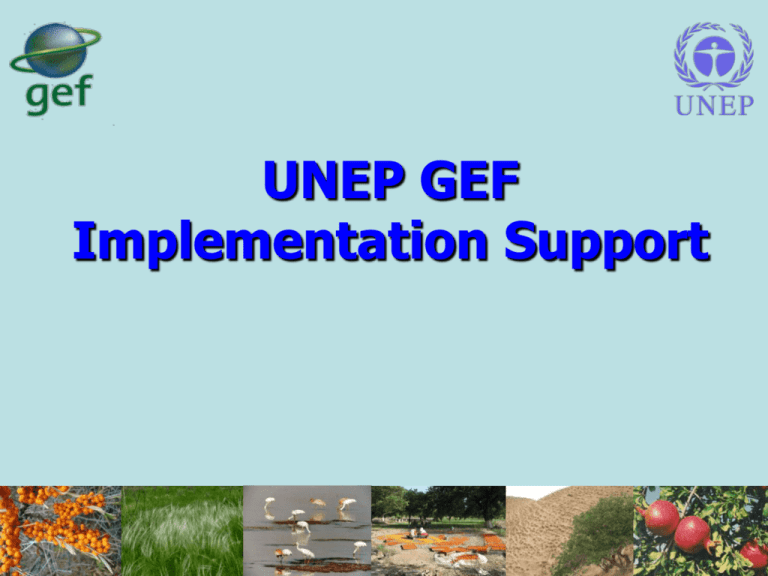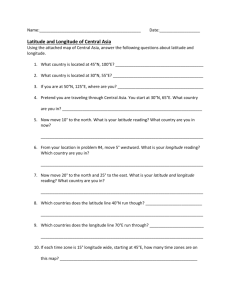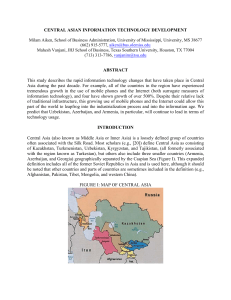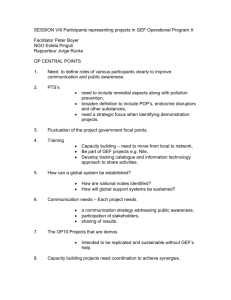UNEP - English - Global Environment Facility
advertisement

UNEP GEF Implementation Support UNEP’s Role in GEF • The only Implementing Agency of the GEF whose core business is the environment; • Supports strategic and policy direction of GEF, and performs legal obligations; • Enhances scientific rigor and relevance, including by providing the secretariat of the STAP; • Help to mainstream environment into other sectors through partnerships (including One-UN, UN REDD, etc.) UNEP’s Comparative Advantages in GEF 1. Scientific assessments, monitoring, early warning; 2. Linking science to policy (Capacity Building, Enabling Activities) at national, regional and global levels; 3. Innovation, technology transfer and lifting barriers; 4. National, multi country-regional, transboundary and global cooperation; 5. Awareness raising, advocacy, and knowledge management. Partnerships UN and Beyond • Governments • International organizations and NGOs (BGCI, CGIAR: Bioversity International, ILRI,CIAT/TSBF, IUCN) • UN organizations programmes: FAO,UNESCO, WTO, WHO,UNEP WCMC, etc. • Science community (Diversitas) UNEP’s MTS 2010 -2013 and Alignment with GEF Climate Change Ban the Climate Change M&A Bulb Ecosystem Mgmt Disasters & Conflict Environment Governance Harmful Substance Resource Efficiency LULUCF and REDD Migration Enabling Activities HCFC Energy use efficiency Biodiversity Adaptation Protected Areas; Mainsteraming BD in production sectors Post conflict restoration Enabling Activities Pollinators Sustain Use, ABS International Waters Adaptation and methane Watershed and coastal areas Floods and droughts TDA, SAP Contaminants Water use efficiency Land Degradation Carbon measuremt Natural Resource Mgmt Drought, Migration Capacity Developmt Pesticides Sustainable Land Managmt Chemicals, POPs and Malaria/DDT HCFC Dioxins Agricultural POPs Enabling Activities POPs Phase out Contaminants Key Elements for Success ● Work through National and International Executing Agencies and partners and with networks at national, regional and global levels; ● Cooperation and shared objectives within the region; ● Strong and sustainable partnerships at all levels; ● Strong local community engagement; ● Qualified and motivated project teams. Biodiversity and Biosafety • Enhancing Conservation of the Critical Network of Sites required by Migratory Waterbirds on the African/Eurasian Flyways (AEWA)" - Short title Wings Over Wetlands (WOW). (Armenia; Azerbaijan; Georgia; Kazakhstan; Russian Federation; Turkmenistan; Uzbekistan) • Development of a Wetland Site and Flyway Network for Conservation of the Siberian Crane and Other Migratory Waterbirds in Asia (China, Iran, Kazakhstan, Russian Federation) • • Development of the Econet for Long-term Conservation of Biodiversity in the Central Asia Ecoregions (Kazakhstan, Kyrgyzstan, Tajikistan, Turkmenistan, Uzbekistan) In-situ Conservation of Crop Wild Relatives through Enhanced Information Management and Field Application (Armenia, Bolivia, Madagascar, Sri Lanka, Uzbekistan) • In Situ/On Farm Conservation and Use of Agricultural Biodiversity (Horticultural Crops and Wild Fruit Species) in Central Asia (Kazakhstan, Kyrgyzstan, Tajikistan, Turkmenistan, Uzbekistan) • • Support for Implementation of the National Biosafety Framework of Republic of Tajikistan GEF 4 PIF Capacity Building for the Development of the National Biosafety Framework of Turkmenistan GEF 4 PIF Land degradation • Support to the Implementation of the Regional Environment Action Plan in Central Asia (RAPCA) (Kazakhstan, Kyrgyzstan, Tajikistan, Turkmenistan, Uzbekistan) • Sustainable Land Management in the BalkhashAlakol Basin (Kazakhstan) • Sustainable Land Management in the High Pamir and Pamir-Alai Mountains – an Integrated and Transboundary Initiative in Central Asia (PALM) (Kyrgyzstan, Tajikistan) Climate Change and International Waters • Expedited Financing Climate Change Enabling Activity (Phase II) (Turkmenistan) • Financing Energy Efficiency and Renewable Energy Investments for Climate Change Mitigation (Belarus, Bulgaria, Kazakhstan, Romania, Russian Federation, Serbia, Ukraine, Macedonia) • Addressing Transboundary Environmental Issues in the Caspian Environment Programme (Phase I) (Azerbaijan, Iran, Kazakhstan, Russian Federation, Turkmenistan) • An Integrated Ecosystem Management Approach to Conserve Biodiversity and Minimize Habitat Fragmentation in Three Selected Model Areas in the Russian Arctic (ECORA) Russian Federation Ozone Depletion • Promoting Compliance with the Trade and Licensing Provision of the Montreal Protocol in Countries with Economies in Transition (CEITs) (Bulgaria, Hungary, Poland, Azerbaijan, Belarus, • Czech Republic, Estonia, Latvia, Lithuania, Slovak Republic, Tajikistan, Turkmenistan, Ukraine, Uzbekistan, Russian Federation) Programme for Phasing Out Ozone Depleting Substances (Azerbaijan, Turkmenistan, Uzbekistan, Tajikistan, Kazakhstan) • Total Sector Methyl Bromide Phase Out in Countries with Economies in Transition (Bulgaria, Hungary, Kazakhstan, Latvia, Lithuania, Poland, Uzbekistan) • Preparing for HCFC phase out in CEITs: needs, benefits and potential synergies with other MEAs (Georgia, Kyrgyzstan, Tajikistan) • Continued Institutional Strengthening Support for CEITs to meet the obligations of the Montreal Protocol (Azerbaijan, Kazakhstan, Tajikistan, Uzbekistan) POPs • Enabling Activities for the Stockholm Convention on Persistent Organic Pollutants (POPs): National Implementation Plan for Republic of Tajikistan • Demonstrating and Scaling Up Sustainable Alternatives to DDT for the control of vector borne diseases in Southern Caucasus and Central Asia (Georgia, Kyrgyzstan, Tajikistan) Key Results To Date • Methodologies and tools for assessments and analysis; • Information and knowledge management tools; • Conservation actions; • Strengthened legislation; • Capacity building, training and public awareness. Prospects for GEF-5 • Conservation and sustainable use of agricultural biodiversity to improve regulating and supporting ecosystem services in agricultural production systems. Armenia, Uzbekistan, Kyrgyz Republic? • National Communications • Russian Federation Partnership on Sustainable Environmental Management in the Arctic under a Rapidly Changing Climate (Arctic Agenda 2020) • Enhancing human security through integrated ecosystem management and community resilience to climate change across mountain communities in the Pamir-Alai Mountains in Central Asia Follow-up to PALM project • Demonstrating and Scaling Up Sustainable Alternatives to DDT for the control of vector borne diseases in Azerbaijan currently under review by GEFSEC • National Implementation Plan (NIP). Russian Federation, Emerging Issues • Nagoya 2010 Action Plan and Aichi targets. • Green economy • Eco-agriculture Thank You! Marieta Sakalian Senior Programme Management/Liaison Officer CGIAR/FAO), Biodiversity Regional Programme Coordinator Europe/CIS UNEP GEF Coordination











